The Mithila Festival in New York features works by 11 artists, including eight Nepali women. Out of 11 artists, 10 women have been selected. Most of the female participants are from remote rural areas of Nepal who have not seen school properly. They are trying to create awareness to help prevent against Covid-19 through art.
Let’s meet them.
Amrita Dutta

I was married at 13, so I never could finish the important 10th grade exam. My husband was mentally unstable but I was too young to understand the situation. I just saw that I had to support my family.
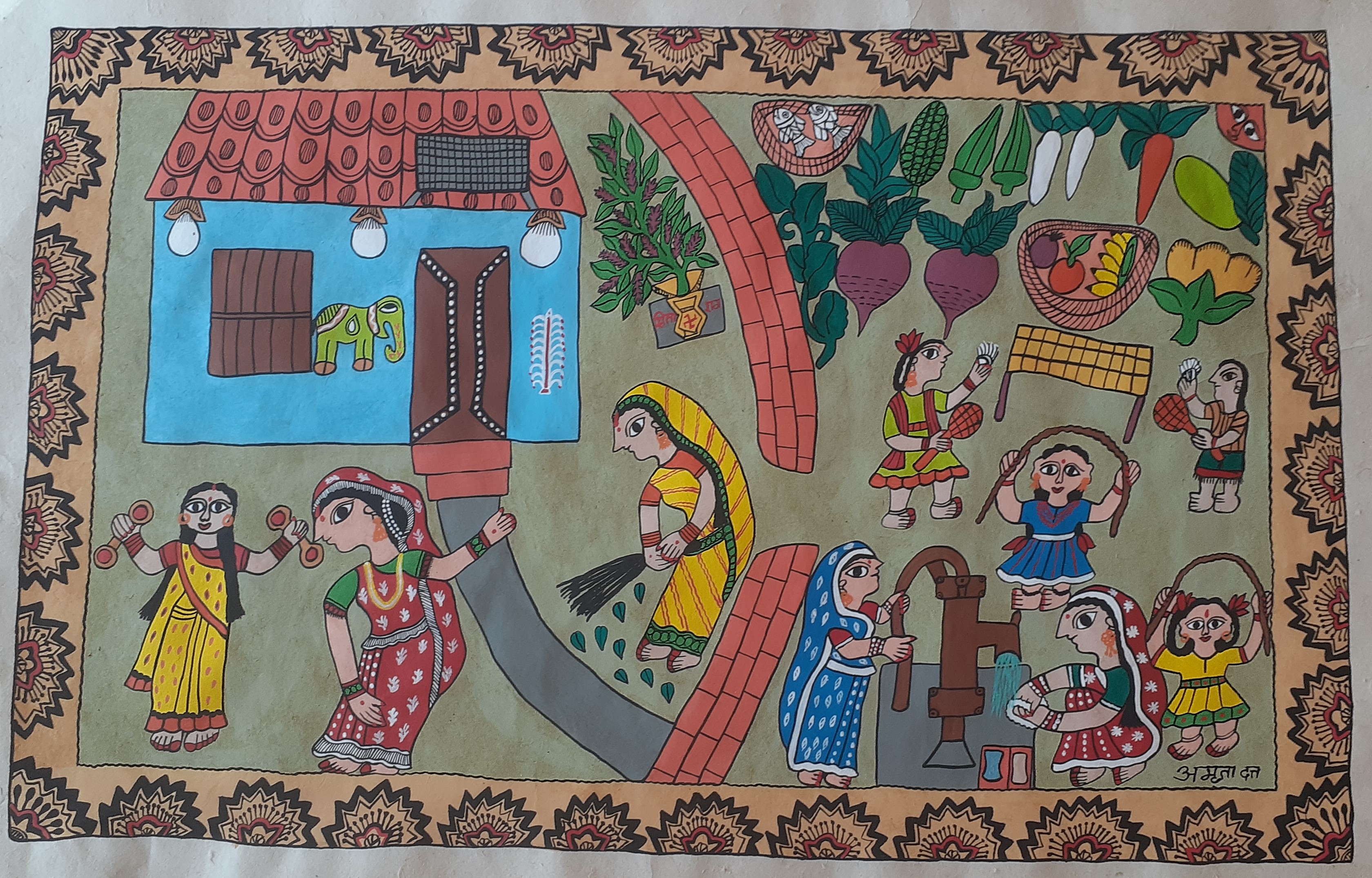
I had no special skills but I had learned to make kohbar (wedding chamber) paintings and aripan (ritual rice paste designs) and these helped me earn a living. I used to sell paintings at piece rate to different buyers. The situation at my house was so dire that I kept myself awake every night just to finish one painting. Still, I could not cover the expenses of my seven family members. Things changed in 2011 when I joined the Janakpur Women’s Development Center and my income as an artist became stable.
Madhula Mandal
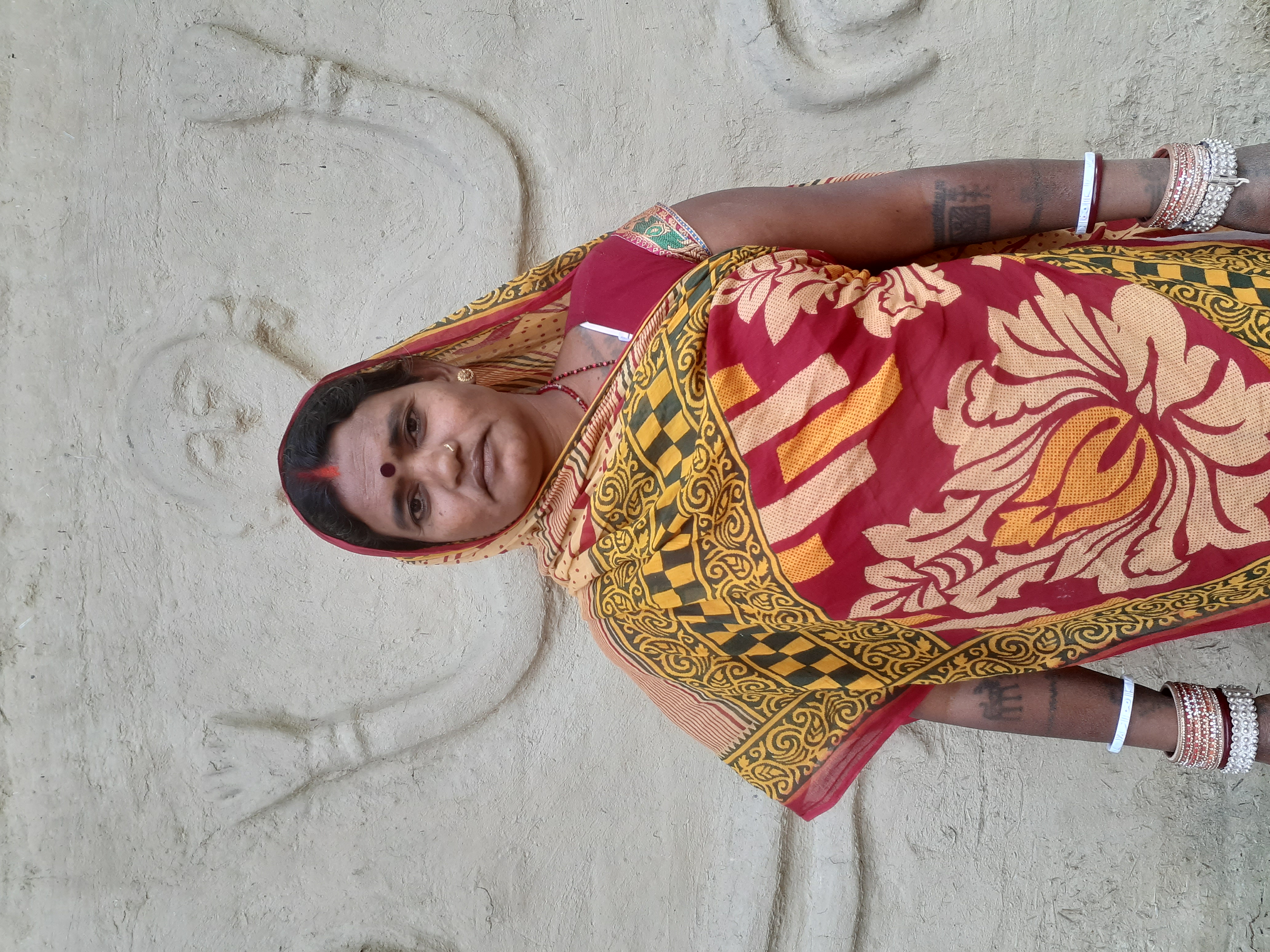
I’m 38 now. When I was 15 my father went to India to earn money. Coming back, he brought many things that were necessary for a wedding. Although those things were all second quality, I was looking forward to the wedding. I knew each other because his aunt lived in our village. My parents had to pay 15,000 rupees for dowry. My in-laws also requested a radio and a bicycle. To me, my father gave only a hansuli (silver necklace) because jewelry lasts a long time whereas other things can easily break.
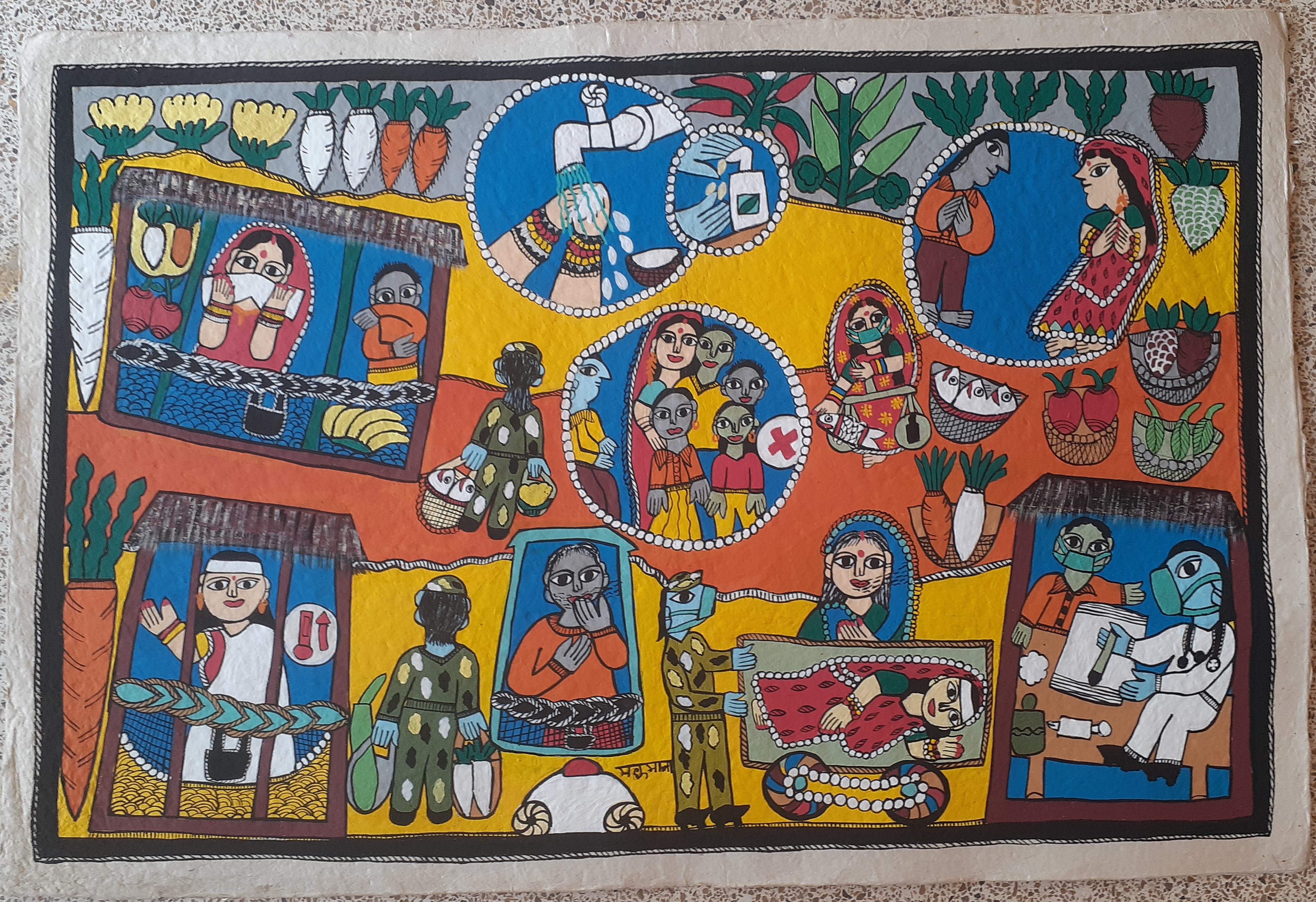
I learned to paint by myself, from what I saw painted on different houses. Usually, I painted at night in the courtyard. My parents asked me to do it during the day, but then there was so much other work that I kept on painting during the night. Our neighbors saw my paintings and asked me to paint their houses. So, I started painting houses for festivals. During that time, people from the JWDC were going to villages to find new artists. I painted my house and was chosen. Usually, I paint daily life situations and tattoos. Tattoos are very important in our culture. If you do not have tattoos, people will not accept you as a member of society. For example, no one will touch your food because they think it will not be tasty.
Manisha Shah
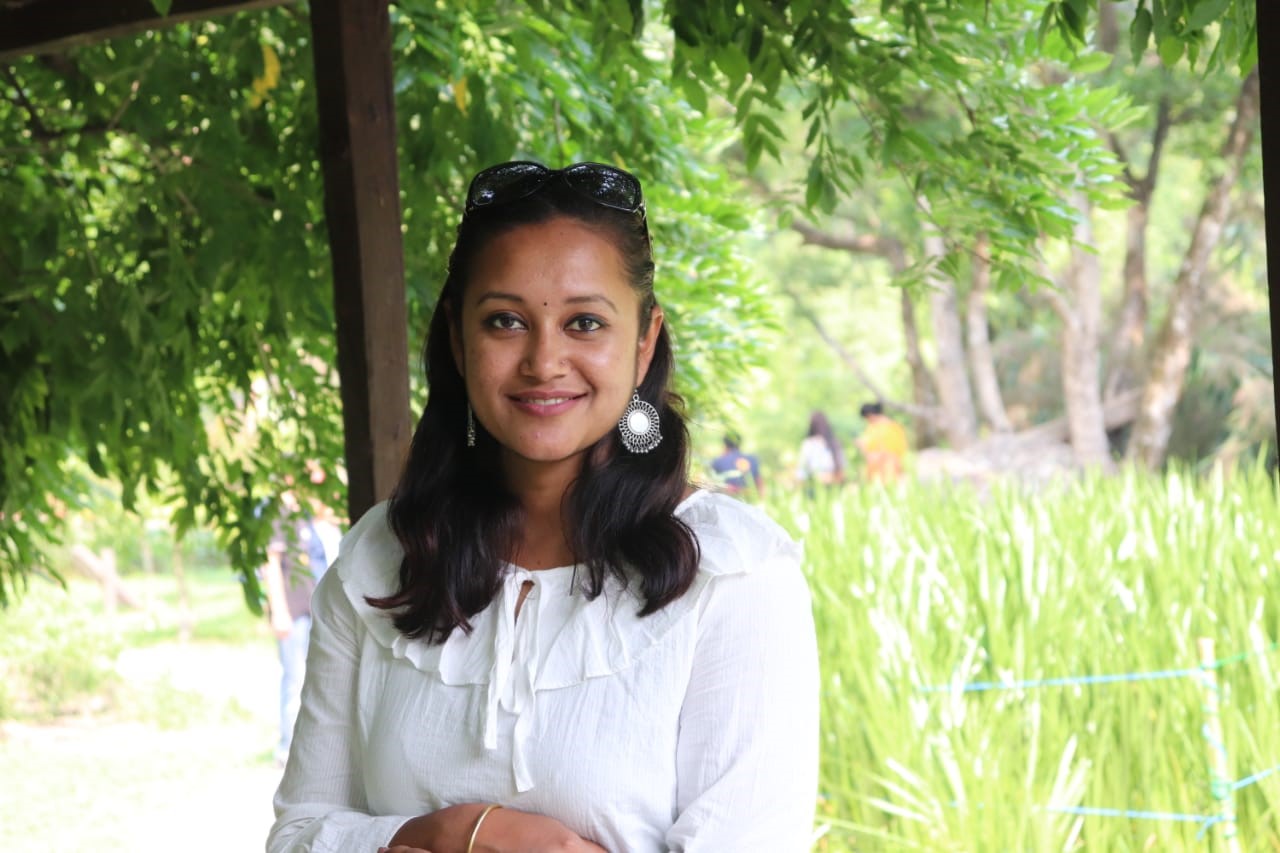
I am Manisha Shah, 24 years modern mithila artist and a Fine art student (BFA) at Lalitkala Campus. Since my childhood, I always use to do lots of paintings at the free time.
I completed my schooling from Monastic H.S.E.B. School, Janakpurdham. I participated in many art and crafts making competition and always stood first or second position in whole school. At that time my school teachers were very supportive, our Principal sir Dr. Mithilesh Shah always encouraged me to move on with my own creativities and used to give me so many chocolates by seeing my paintings which brings smile to my face and I used to become so much happy. But it was a bad luck that there was drawing subject made compulsory only up to 5 class and after that this subject was removed from the syllabus.
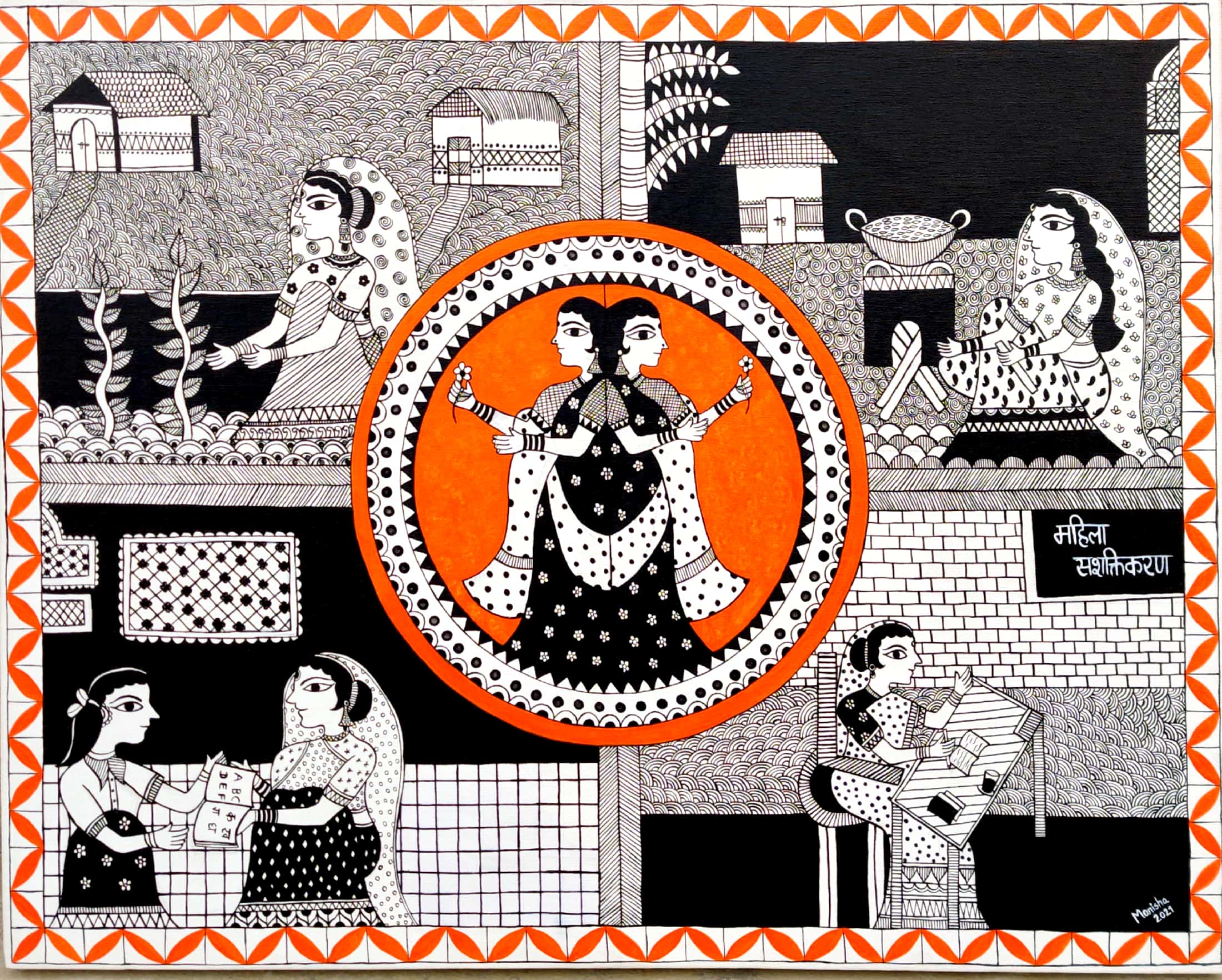 Despite this, I used to make so many drawings on theme which was in our Social Studies subject and also used to make map of Nepal nearly of all my friends. One of my best friends, her name is Aarti Mahaseth, she used to tell me and her parents that if Manisha parents will not teach her fine arts, I will support her and when I will earn, I will get her admitted in fine art with my salary which made me feel so blessed to have such supporting and loving friend. But at the same side, at home when I used to do painting in leisure time, my mother and father always used to scold me that what you keep doing all the time, it will harm your eyes which used to make me feel disappointed sometimes still I didn’t stop.
Despite this, I used to make so many drawings on theme which was in our Social Studies subject and also used to make map of Nepal nearly of all my friends. One of my best friends, her name is Aarti Mahaseth, she used to tell me and her parents that if Manisha parents will not teach her fine arts, I will support her and when I will earn, I will get her admitted in fine art with my salary which made me feel so blessed to have such supporting and loving friend. But at the same side, at home when I used to do painting in leisure time, my mother and father always used to scold me that what you keep doing all the time, it will harm your eyes which used to make me feel disappointed sometimes still I didn’t stop.
My parents wanted me to join medical field and I gave so many entrance examinations as well but it’s said ” No one can change what’s already written by God in your life”, the same thing happened. When I was waiting for my admission in Bachelor level, my father’s friend, a great and so senior print- making artist of Nepal Mr. UmaShankar Shah and Dr. Seema Sharma Shah told him about lalitkala campus. They saw my paintings which was hang over the wall at my house. They appreciated and also supported so much. Then finally I joined BFA after passing entrance exam and got to learn so many basics and interesting thing about Painting. And it’s a bad luck again that in our BFA curriculum, there is nothing about Mithila painting which made me feel sad but still I didn’t lose my hope and thought being from Janakpur, it’s my responsibility to promote and keep continuity to mithila painting.
After I started making paintings little bit different from others like painting giving some messages to our society. I started making theme-based painting mostly showing women violence, social issues, sanitation and others. It’s hard to survive in Nepal, being a Mithila artist but still I am waiting for the time when the artist will also get the same respect and honor which a doctor or engineer gets in our country. There are some senior and very well-known artist like Ajit Shah, Umesh Shah and our college teachers and friends who always supported me to move on with more creativities.
Manjula Thakur
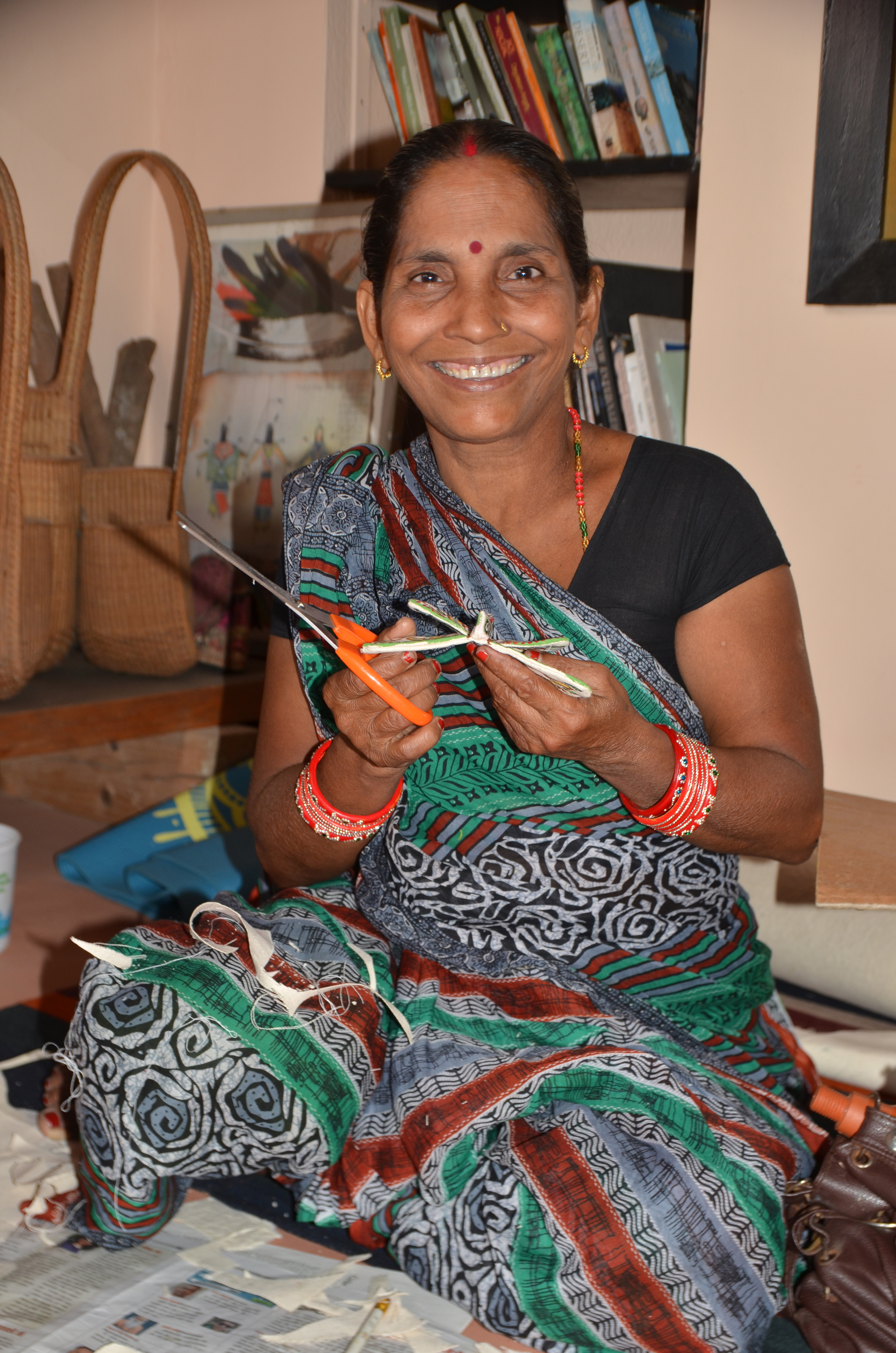
At twelve, what did I know? My grandfather had invited a visitor to come meet me, and my mother combed my hair and coached me to give the guest water to wash his feet. The guest was pleased with me, and so my marriage to a boy of my age in a distant village was fixed.

After my third son I myself decided to have a family planning operation. It was painful, and I didn’t want the 100 rupees the doctor gave me. At that time, I didn’t know what I would do to educate my sons so I bought 15 hens and began selling the eggs. Then everyone forgave me for having the operation because I was so industrious. Still, we didn’t have rice, so when a foreigner appeared in our village asking if people could paint, I made some samples even though I was too shy to speak to her. I’d learned painting from my mother who would paint gods on the pavilion we Brahmins build for boys ́ haircutting ceremonies. Now I am the manager for the painting section at JWDC.
Namrata Singh
 I am Namrata Singh Contemporary Artist from Mahottari, Nepal and currently I am working as freelancer artist in Kathmandu Nepal. I received my Master’s Degree in Fine Arts from TU, Kirtipur Nepal. My artistic process began as a child during frequent excursions to the Terai areas which is rich in varieties of culture and tradition. Now, my primary source of inspiration is from my own life experiences and others in day-to-day life with the flavors of richly diverse subject matters which comes from Mithila Tradition.
I am Namrata Singh Contemporary Artist from Mahottari, Nepal and currently I am working as freelancer artist in Kathmandu Nepal. I received my Master’s Degree in Fine Arts from TU, Kirtipur Nepal. My artistic process began as a child during frequent excursions to the Terai areas which is rich in varieties of culture and tradition. Now, my primary source of inspiration is from my own life experiences and others in day-to-day life with the flavors of richly diverse subject matters which comes from Mithila Tradition.

In my work mostly my paintings depict the positive aspects of life which inspires me to move forward in my work and life. Strong lines on the figures and dark shade on the faces of the figures represents the different shades in life. On the other side vibrant and bright colors of Mithila art represents the happy, joy, love and inspiring aspects of life full of positivity. On the foreground Mithila motifs and symbols are displayed as the positive and strong character of the subject. In my work the affections between the mother and daughter, the love between husband and wife, the connections between human and nature, these subjects are always hovering around my paintings.
Participation on different workshop and talk program are my field of interest where I am eager to engage myself. Participation in SAARC Artist camp and Exhibition of Paintings-Nepal 2017 and Revived Emotion Group Art Exhibition, Thailand 2020 was a great experience with different senior national and international artist. So far, my second solo exhibition Fragrance of Life 2 was held in Newa Chen gallery and I was honored by the Title Artist of the Year 2017.
Nupur Nishith

An Artist based in USA inspired from my native Mithila / Madhubani Art. Growing up in the environment famous for its unique ancient folk art I took up the art early observing my mother, first Phd in History of Mithila Paintings. Even during education and profession in marketing and banking my passion for Mithila art continued through exhibitions and workshops in India. Since moving to US, my explorative nature led to paintings on various surfaces from paper, canvas, cloth, wood, ceramic, terra cotta, glass, aluminum and 3D installations to murals on walls, ceilings, floors, windows etc. Eventually evolved my own distinct style in the contemporary world with traditional art form using modern themes and tools.
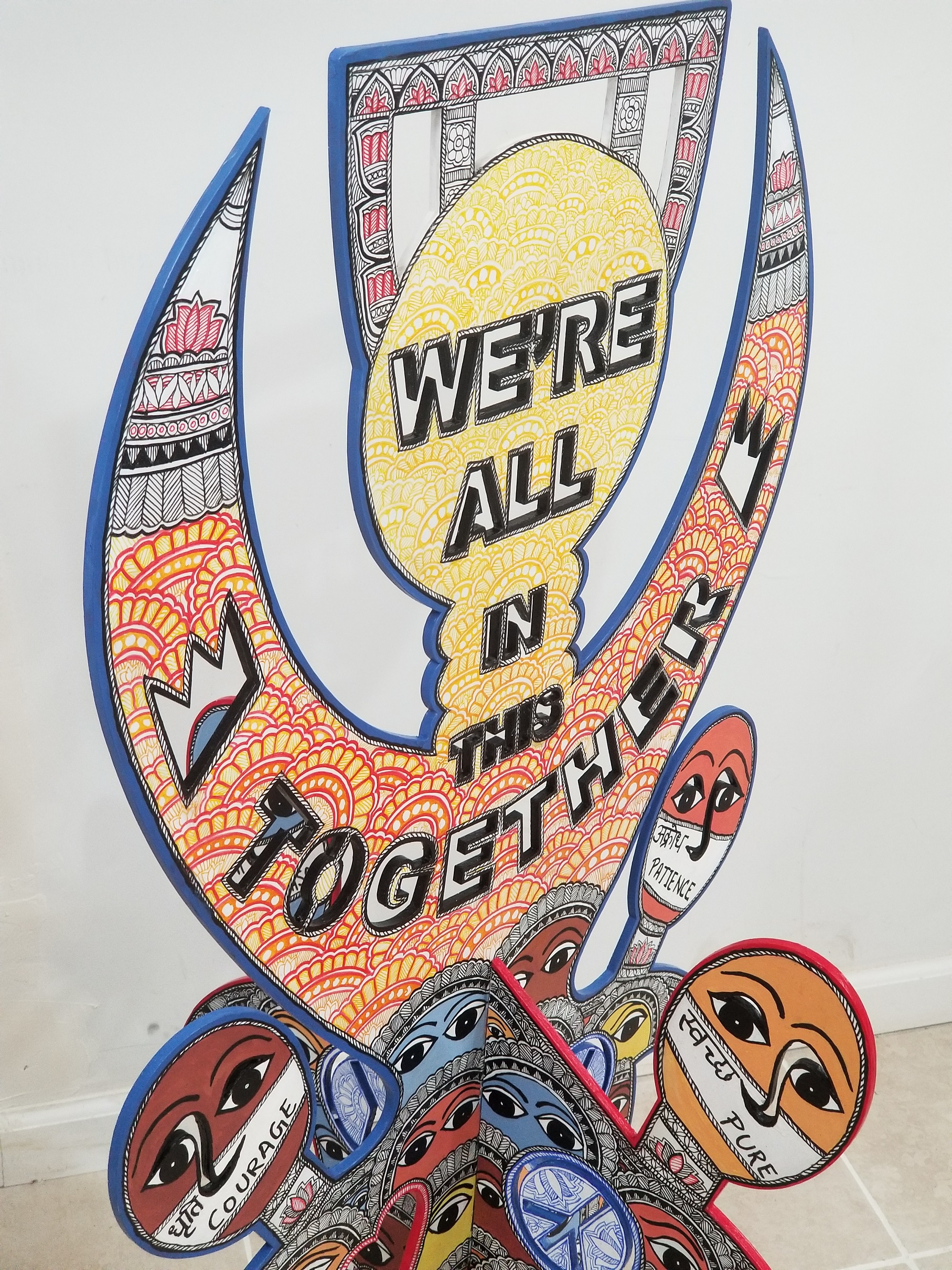
A professional art career of six years in my paintings have been awards, exhibited, published at various occasions globally. Art displayed in the collection of likes of Abigail Disney (from Disney family), Dr Harvey Manes and many others, showcased at CBS NY Sunday Morning Show, Asian Art Museum, SFO and Nassau County Museum of Art, NY and various galleries and events, awarded by juror from Museum of Modern Art, NY and many significant others, exhibitions reviewed in Huffington post, The Daily California among others. Featured as Artist and Art activist at various occasions. A pioneer in digital Mithila art, my designs featured on Indian National award-winning movie Mithila Makhaan. An Art ambassador for social causes with Association for Promotion of Creative Learning (APCL), Ekal Vidalayas and other organizations. Board of various Artist groups including former Vice President, Pro Arts, NJ. Speaker at various national and international events on Art and Culture of Mithila, Bihar and India. Curated and organized various art exhibitions and events.
My paintings are developed through some intense observation, exploration, research and experiments within the framework of traditional motifs of Mithila Art. So, every piece has a story behind the scenes.
Sudhira Karn

At first, I was lucky. My parents could afford to send me to school. But unfortunately, in eighth grade my father became ill. Then we did not have the money for school anymore.
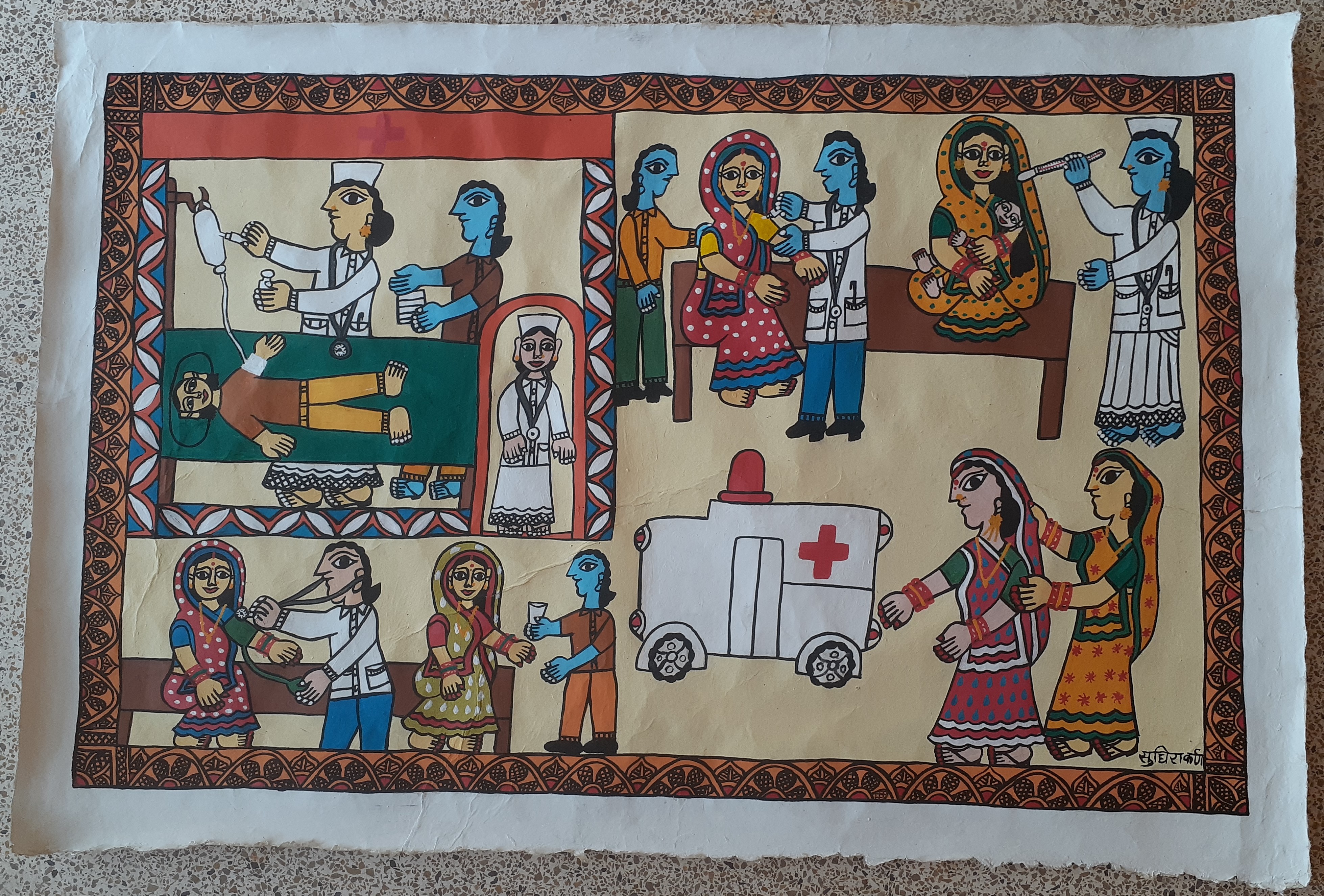
I was already 25 when my parents arranged my marriage. For this they paid 75,000 rupees. My husband and I met only after the marriage. When my husband died a few years later, my life became difficult. I did not have any money and I did not want to stay at the house of my in-laws since they were uneducated. I wanted my son to study. So, I moved back to my parents’ house and started to work at the JWDC. Because I work in the Center, I can also support my family. I decide by myself what to use the money for. So, I have gained a lot of independence and my son is studying. After the death of my husband, I felt so hopeless. My colleagues here helped me and I also found many new friends.
When I was young, I learned painting from my grandmother and mother. They used to paint our house for rituals. My favorite paintings are about gods and goddesses. I especially like to paint the love story of Radha and Krishna and the wedding ceremony of Sita and Rama.
Pano Das

I am Pano Das, a resident of Ward No.11 of Janakpurdham city. I got married at the age of 13 and started living in Janakpurdham. My husband and myself have lived together with our two daughters and one son and my parents-in-law (altogether seven) in a joint family. Our family’s financial condition was not good. For making a living, we raised cattle such as cows and goats. While doing this animal husbandry, I was keenly looking for a salaried job.
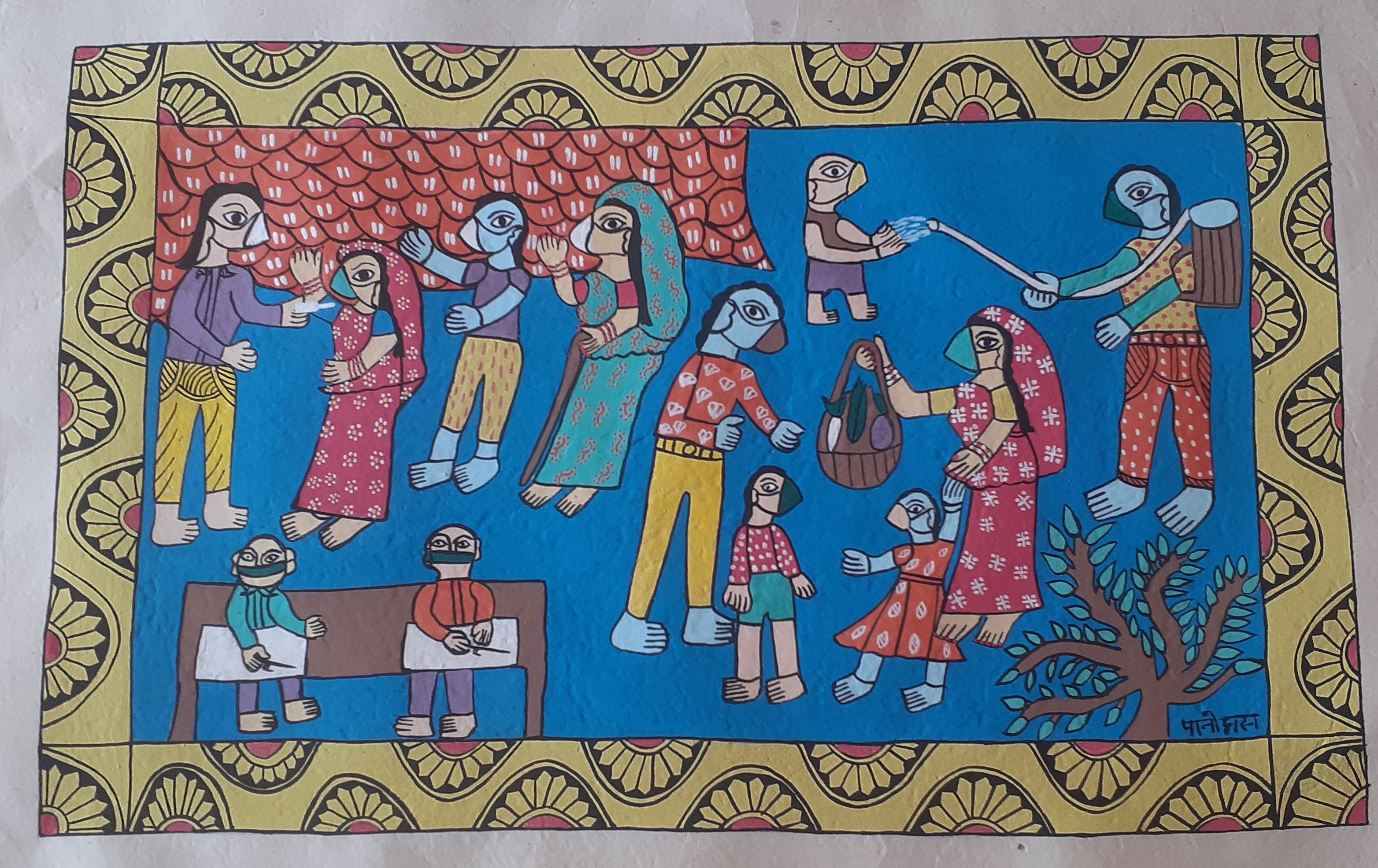
In 1994, I was selected for a job, through an interview, of making Mithila paintings at the Janakpur Women Development Centre. Although this is not a high-income job, I enjoy working with other sisters (workers) working there in a friendly environment. I had also got a chance to visit Kathmandu also for making children’s painting. We had also got opportunities to meet with Ambassadors and diplomats of other countries when they visited our Centre.
The earnings from my job helped my children’s education as well. For about 27 years, I have been making Mithila paintings which represent Mithila culture and daily life of Mithila people.
S.C. Suman
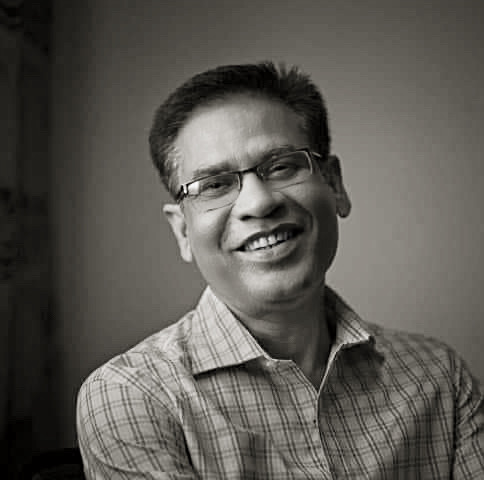
Since the beginning of my pioneer work in the field of Mithila painting. I have juxtaposed contemporary issues with the traditional form, natural colors and spiritual aesthetics of my native land. I have simply found myself as a link in the long heritage in the development of this home- grown works of art and have brought the techniques, tools and the outline (which were in the verge of extinction) of our social semiotics at the forefront of the international community. While doing so, my grandmother, surrounding nature and my keen observation has proved to be the source of inspiration for me. The progressive time has father motivated me to grab in the social change in my paintings.
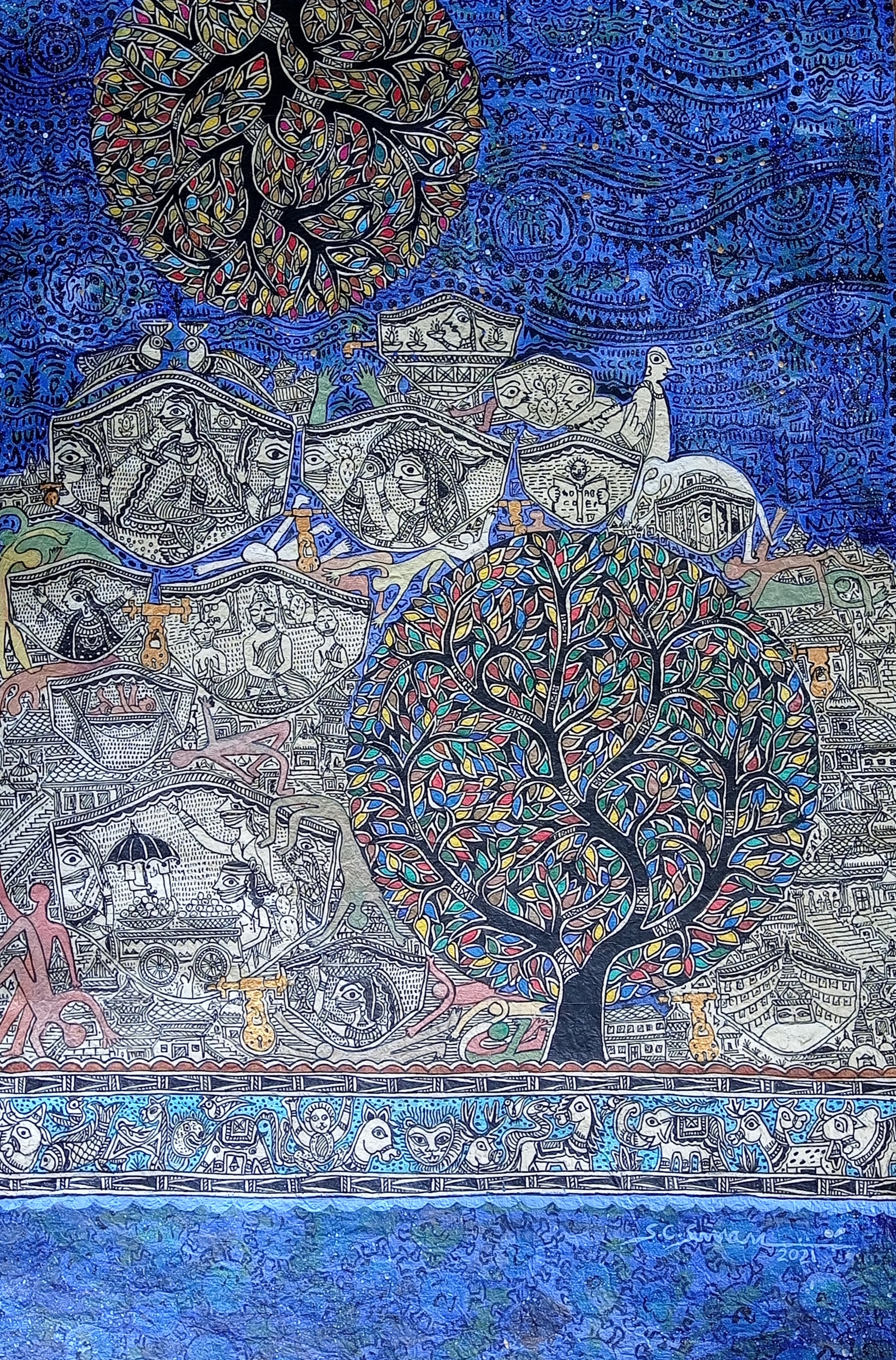
To sum up, Mithila art is original to its surrounding nature. It is an ancient, an indigenous and traditional one it is getting modernized day by day. My special focus is to revive traditional techniques, natural pigments and aware people through aesthetic means of Mithila arts. Also distinguishes himself with a flair for incorporating issues of contemporaneous political conflict and social disharmony prevalent after earthquake of 2015 that devastated, Nepal also finds expression in this series. Titled Rebuild Nepal, the triptych expresses the plain felt by the artist and the people of Mdhesh over the death and destruction caused by earthquake. Work mourns the loss an ancient heritage that drew Mithila sages and pilgrims to the valley. My portrays the humanitarian assistance provided by those effected by the earthquake.
Sweta Jha

I love nature, its myriad colors, moods and diversity. Being born in a traditional Mithila family, I opened my eyes to see this abundance of nature all around that got further accentuated by Madhubani art that I inherited as a legacy. I naturally and unconsciously picked it up at a very early age. My fascination and avidity to learn more about this enigmatic art continued to grow by the time I reached college and university levels. But it was only after marriage and when I moved to Singapore in 2007, I began to seriously pursue my thought of taking my gift to the whole world in a more professional and structured way.

I draw my inspiration largely from the nature and sweet nothings of life that my fellow womenfolk who go through its everyday grind. I pay attention to simple everyday things, such as: kids playing or how they interact with the world, a gorgeous sunset, a falling leaf, serenity of Buddha etc. Any of these elements can trigger my mood to pick up my pen and inspire me to paint to draw.
My Unique Artistic Approach: The fine lines of my works have been pulled from the deep and long tradition of the Mithila / Madhubani art form and then married to modern metaphors under the delicate ministering. Mithila/Madhubani art was essentially a ritual ‘Community Art’ practiced by womenfolk of Mithila region from North-East India. Over the years, though, it has broken bounds, adopted new manifestations and expanded its constituency. My works mark a departure not merely of newly and widely imagined themes. I have also brought to this form an entirely new idiom of tone and tenor. Monotones and pastels, for instance, have rarely been infused into the Mithila/Madhubani art form before I began to experiment them. Neither have human figures which, in my eyes, become a fascinating fusion of race and geography. This is an entirely novel line of work from my varied portfolio.
It has always been a passion for me to work with fine lines that are very similar to the tradition of miniature paintings. Working with lines to the minute details and trying to give expressions to the characters in these paintings, and changing this traditional painting from very flat to a three dimensional and perspective effect has been like a great journey. As an artist with a traditional background, it was very difficult and also very interesting to break away from the traditional to modern figures and subjects while also trying to work on the traditional lines so as to maintain and preserve the familiarity with its rich traditional legacy.
Sunaina Thakur
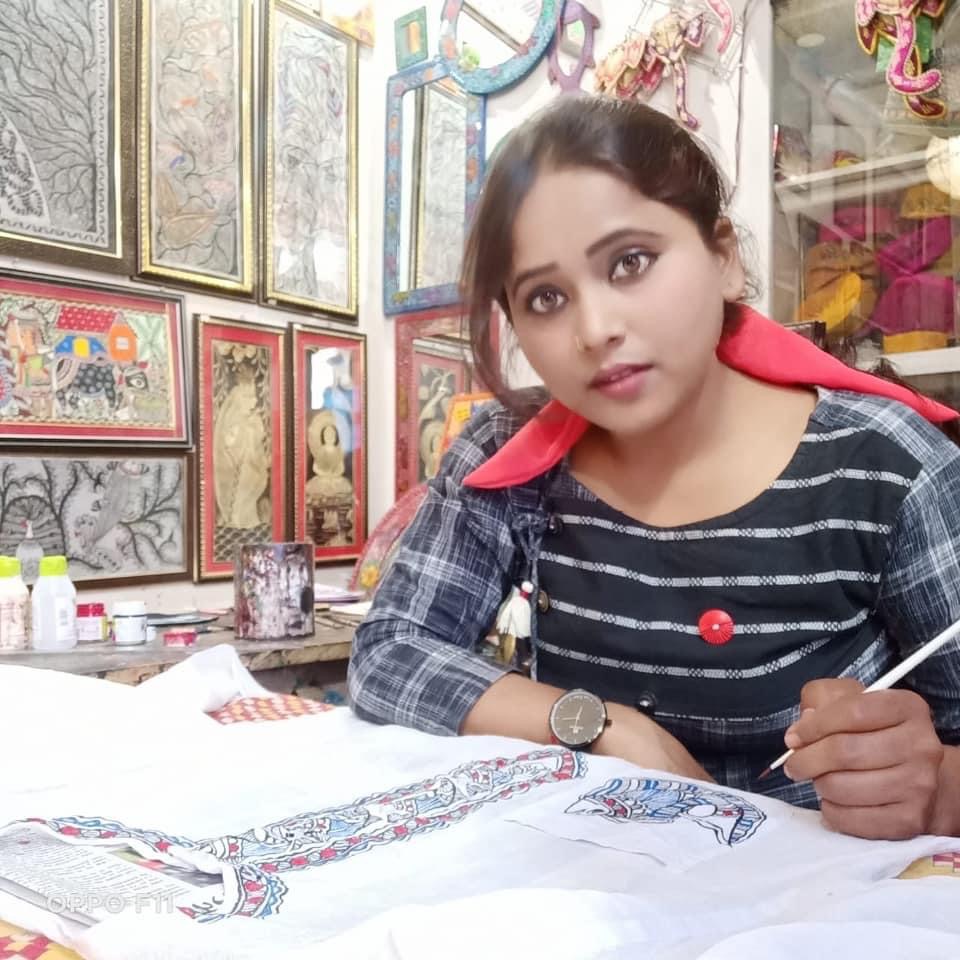
I am Sunaina Thakur, belong from remote village of Nepal and at the age of 12 I have desire to know about Mithila art which I found on mud walls in our village. I was always taking participation in drawing competition at our school. I went so many places to learn about Mithila art and culture like India and remote places Nepal.

I am daughter of Mr. Ram Chandar Thakur and chhatiya Devi. Imarried with Mr. Shambhu Thakur. I get great support from my husband to change my life. After married completed my bachelor’s degree and now running in master degree. Now, I have started mithila arts gallery at Janakpurdham and Kathmandu. I have trained more than four hundred women and College level students where 20 women has got chance for employment.I have participated many exhibitions at Nepal, India, Shree lanka, and organized solo exhibition at six times like Kathmandu, Janakpur, Jaleshwor, New work (USA), Tokyo & Osaka (Japan). In Nepal my exhibition was inaugurated and observed by very notable personalities like former president Dr. Ram Baran Yadav, Chief Minister of Provenance -2, Narayan Kaj Shrestha, CEO of Nepal Tourism Board, Maha Nayak Rajesh Hamal, Manisha Koirala etc.
I have got so many awards like N- Peace Award (2012), Common Ground Award, Safal Manila Udhmi, Lalit Kala Special and National Award (2018), Best Painting Award (2018), In India 100 Heroes of Madhesh Award 2019, Grand Sangati Award 2019, Women of the Year Award (2021) from India etc. And many others.my arts have reached many countries like India, China, Japan, Australia, USA, London, Canada, Shree Lanka and Poland.
Photo: Mithila Center USA


